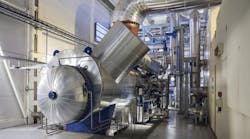The previous “Applications Corner” column (page 4, Feb. 2011) discussed a vortex-shedding flowmeter that was specified for a liquid with an operating specific gravity, temperature, and viscosity of 1.2, 110 C, and 140 cSt, respectively, in a 14-inch line. The flowmeter measured correctly after its configuration was changed to reflect the physical properties of the actual liquid and the 16-inch pipe in which it was installed. Problem solved?
Not so fast. The flowmeter was now reported to be measuring correctly, however it was also dropping out to zero flow. Depending on design, vortex-shedding flowmeters require a minimum Reynolds number of (say) 5,000 in order to function accurately and reliably. Below their minimum Reynolds number constraint, vortex-shedding flowmeters turn off and measure zero flow – even when the liquid velocity is high.
Calculations revealed that the increased pipe size and relatively high viscosity coupled with a somewhat low flow velocity resulted in an operating Reynolds number that marginally violated the minimum Reynolds number-constraint of the flowmeter. In other words, the application of a vortex-shedding flowmeter in this application was likely not the best selection.
Note that my client initially did not fully describe the problem at hand. When questioned, he confirmed that the flowmeter was initially measuring incorrectly and dropping out. Not mentioning the dropouts would lead one to believe that the flowmeter measurement was steady (but incorrect), so Reynolds number constraints were not initially investigated. Initial mention of the dropouts would have prompted a calculation of Reynolds number and the discovery of a likely violation of hydraulic constraints.
Solving a problem is not a guessing game or a quiz, so you would think that people would transmit all of their observations so as to help diagnose the problem. This may be routine for some, but it is not necessarily practiced universally. The thought here is to keep asking questions until you are satisfied that you have a complete working knowledge of the installation that includes all relevant observations.
What can be done to remedy this installation? More next month.
David W. Spitzer is a regular contributor to Flow Control with more than 35 years of experience in specifying, building, installing, startup, troubleshooting and teaching process control instrumentation. Mr. Spitzer has written over 10 books and 150 technical articles about instrumentation and process control, including the popular “Consumer Guide” series that compares flowmeters by supplier. Mr. Spitzer is a principal in Spitzer and Boyes LLC, offering engineering, expert witness, development, marketing, and distribution consulting for manufacturing and automation companies. He can be reached at 845 623-1830.
www.spitzerandboyes.com



